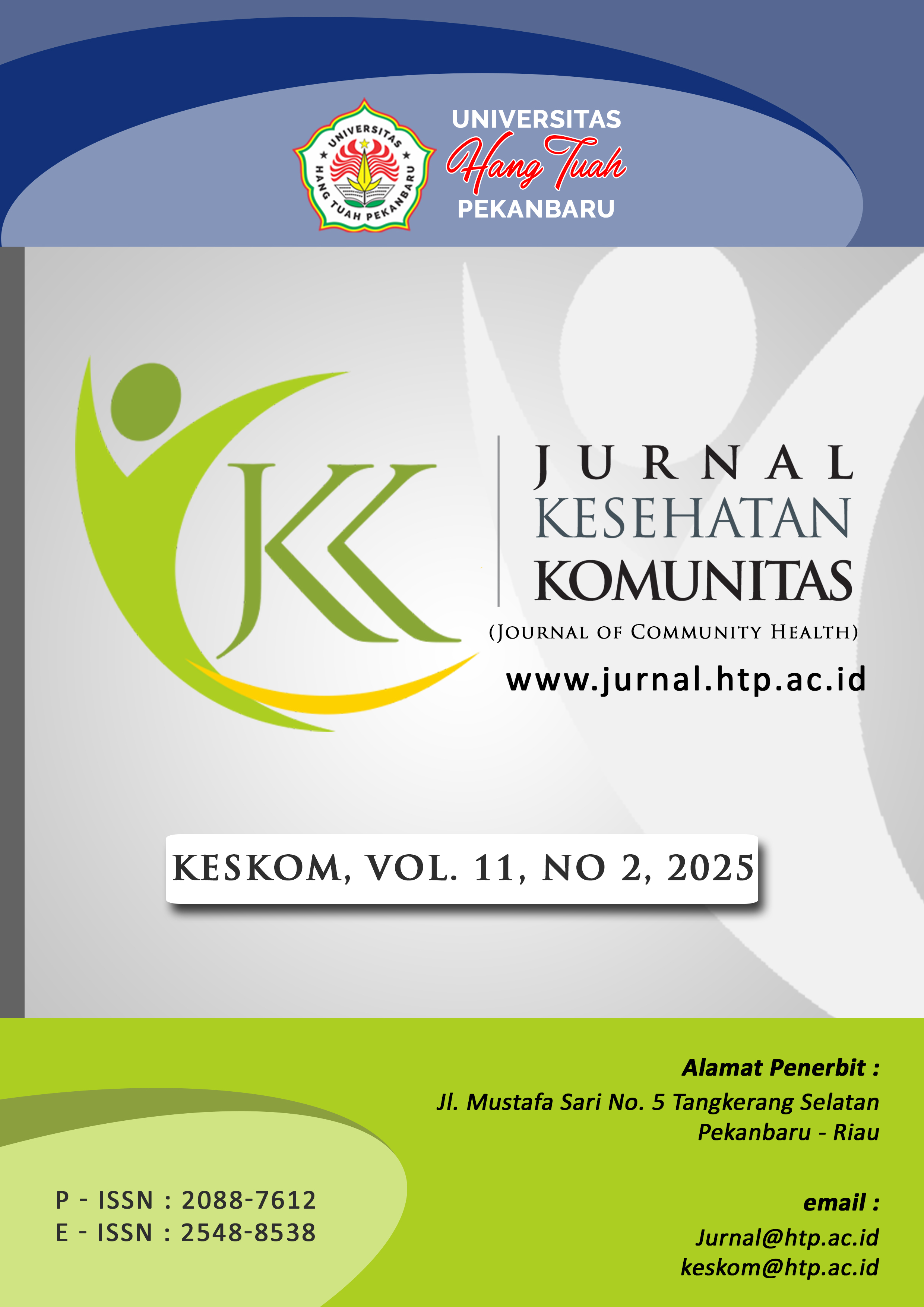Pengaruh Sikap Pekerja dalam Theory of Planned Behavior terhadap Kepatuhan Keselamatan dan Kesehatan Kerja di Pabrik Minyak Kelapa Sawit
DOI:
https://doi.org/10.25311/keskom.Vol11.Iss2.2215Keywords:
Occupational Health and Safety;, Workers’ Attitudes; Theory of Planned Behavior (TPB)Abstract
Occupational Health and Safety (OHS) is a crucial factor in the palm oil mill industry, which has a high risk of workplace accidents. The Theory of Planned Behavior (TPB) provides a framework for understanding how workers' attitudes, risk awareness, and commitment to safety behavior influence compliance with safety procedures and the reduction of workplace accidents.This study aims to analyze the influence of workers' attitudes, risk awareness, and commitment to safety behavior on safety compliance and accident reduction in palm oil mills. A quantitative cross-sectional approach was used, with 200 respondents from palm oil mill workers. Data were collected through questionnaires and analyzed using Structural Equation Modeling-Partial Least Squares (SEM-PLS) with SmartPLS 4.0 to examine the relationships between variables.The results show that positive worker attitudes significantly influence safety procedure compliance (path coefficient = 0.323, p < 0.05) and accident reduction (path coefficient = 0.303, p < 0.05). Risk awareness has a significant effect on safety procedure compliance (path coefficient = 0.218, p < 0.05) and accident reduction (path coefficient = 0.223, p < 0.05). Furthermore, commitment to safety behavior positively influences safety procedure compliance (path coefficient = 0.248, p < 0.05) and accident reduction (path coefficient = 0.343, p < 0.05). The research model demonstrated R² values of 0.456 for compliance and 0.556 for accident reduction, indicating a moderate influence.
Downloads
References
1. Pemerintah Republik Indonesia. Peraturan Pemerintah Republik Indonesia Nomor 50 Tahun 2012 tentang Penerapan Sistem Manajemen Keselamatan dan Kesehatan Kerja. Jakarta: Kementerian Sekretariat Negara RI; 2012. https://peraturan.go.id
2. Jilcha K, Kitaw D. Industrial occupational safety and health innovation for sustainable development. Eng Sci Technol Int J. 2017;20(2):372-80. doi:10.1016/j.jestch.2016.10.011. DOI: https://doi.org/10.1016/j.jestch.2016.10.011
3. Kementerian Tenaga Kerja Republik Indonesia. Peraturan Menteri Tenaga Kerja Nomor 03/MEN/1998 tentang Tata Cara Pelaporan dan Pemeriksaan Kecelakaan. Jakarta: Kementerian Tenaga Kerja; 1998.
4. Kementerian Ketenagakerjaan Republik Indonesia. Peraturan Menteri Ketenagakerjaan Republik Indonesia Nomor 1 Tahun 2022 tentang Organisasi dan Tata Kerja Unit Pelaksana Teknis di Kementerian Ketenagakerjaan. Jakarta: Kementerian Ketenagakerjaan; 2022.
5. Kementerian Ketenagakerjaan Republik Indonesia. Kumpulan Data Kementerian Ketenagakerjaan [Internet]. Jakarta: Kementerian Ketenagakerjaan; 2022 [diakses pada 14 Januari 2025]. Tersedia dari: https://satudata.kemnaker.go.id/data/kumpulan-data/1728.
6. Data Indonesia. RI alami 265.334 kasus kecelakaan kerja hingga November 2022 [Internet]. Jakarta: Data Indonesia; 2022 [diakses pada 14 Mar 2025]. Tersedia dari: https://dataindonesia.id/tenaga-kerja/detail/ri-alami-265334-kasus-kecelakaan-kerja-hingga-november-2022.
7. Ajzen I. The theory of planned behavior. Organ Behav Hum Decis Process. 1991;50(2):179-211. doi:10.1016/0749-5978(91)90020-T. DOI: https://doi.org/10.1016/0749-5978(91)90020-T
8. Hidayatullah A, Tjahjawati SS. Pengaruh keselamatan dan kesehatan kerja terhadap produktivitas kerja karyawan. J Riset Bisnis Invest. 2017;3(2):104-111.
9. Nasrullah M, Suwandi T. Hubungan antara knowledge, attitude, practice safe behavior pekerja dalam upaya untuk menegakkan keselamatan dan kesehatan kerja. Indones J Occup Saf Health. 2014;3(1):82-93.
10. Rahayu EP. Hubungan antara pengetahuan, sikap, dan perilaku karyawan dengan penerapan manajemen budaya keselamatan dan kesehatan kerja. J Kesehatan Komunitas. 2015;2(6):289-93.
11. Hair JF, Risher JJ, Sarstedt M, Ringle CM. When to use and how to report the results of PLS-SEM. Eur Bus Rev. 2019;31(1):2-24. doi:10.1108/EBR-11-2018-0203. DOI: https://doi.org/10.1108/EBR-11-2018-0203
12. Sarstedt M, Ringle CM, Hair JF. Partial least squares structural equation modeling. In: Homburg C, Klarmann M, Vomberg A, editors. Handbook of Market Research. Springer Nature Switzerland; 2021. p. 1-38. doi:10.1007/978-3-319-05542-8_15-2. DOI: https://doi.org/10.1007/978-3-319-05542-8_15-2
13. Nasrullah M, Suwandi T. Hubungan antara knowledge, attitude, practice safe behavior pekerja dalam upaya untuk menegakkan keselamatan dan kesehatan kerja. Indones J Occup Saf Health. 2014;3(1):82-93.
14. Hidayatullah A, Tjahjawati SS. Pengaruh keselamatan dan kesehatan kerja terhadap produktivitas kerja karyawan. J Riset Bisnis Invest. 2017;3(2):104-111. DOI: https://doi.org/10.35313/jrbi.v3i2.938
15. Rahayu EP. Hubungan antara pengetahuan, sikap, dan perilaku karyawan dengan penerapan manajemen budaya keselamatan dan kesehatan kerja. J Kesehatan Komunitas. 2015;2(6):289-93. DOI: https://doi.org/10.25311/jkk.Vol2.Iss6.91
16. Farihah R. Hubungan antara sikap karyawan terhadap penerapan keselamatan dan kesehatan kerja (K3) dengan produktivitas karyawan PT Toyotetsu Corporation [Skripsi]. Jakarta: Universitas Islam Negeri Syarif Hidayatullah; 2006.
17. Theodora O. Pengaruh motivasi kerja terhadap kinerja karyawan PT Sejahtera Motor Gemilang. AGORA. 2015;3(2):187-95.
18. Zulkifly SS, Zabidi N, Harith SH, Shamsudin MS, Yusof M, Zain AZM. Investigating the dynamic interactions between safety knowledge, attitudes, behavior, and workplace accidents among solid waste management personnel. Int J Safety Security Eng. 2024;14(6):1941-8. doi:10.18280/ijsse.140628. DOI: https://doi.org/10.18280/ijsse.140628
19. Brewer NT, Weinstein ND, Cuite CL, Herrington JE Jr. Risk perceptions and their relation to risk behavior. Ann Behav Med. 2004;27(2):125-30. doi:10.1207/s15324796abm2702_7. DOI: https://doi.org/10.1207/s15324796abm2702_7
20. Budhathoki SS, Singh SB, Sagtani RA, Niraula SR, Pokharel PK. Awareness of occupational hazards and use of safety measures among welders: a cross-sectional study from eastern Nepal. BMJ Open. 2014;4:e004646. doi:10.1136/bmjopen-2013-004646. DOI: https://doi.org/10.1136/bmjopen-2013-004646
21. Braeckman L, Verbrugghe M, Janssens H, Verpraet R, Cobbaut L. Awareness, knowledge, and practices regarding occupational hazards among medical students: a longitudinal study before and after admission as trainees. J Occup Environ Med. 2017;59(4):e41-7. doi:10.1097/JOM.0000000000000972. DOI: https://doi.org/10.1097/JOM.0000000000000972
22. Faremi FA, Ogunfowokan AA, Mbada C, Olatubi MI, Ogungbemi AV. Occupational hazard awareness and safety practices among Nigerian sawmill workers. Int J Med Sci Public Health. 2014;3(10):1244-8. doi:10.5455/ijmsph.2014.260620142. DOI: https://doi.org/10.5455/ijmsph.2014.260620142
23. Patyk M, Nowak-Senderowska D. Occupational risk assessment based on employees’ knowledge and awareness of hazards in mining. Int J Coal Sci Technol. 2022;9:75. doi:10.1007/s40789-022-00554-5. DOI: https://doi.org/10.1007/s40789-022-00554-5
24. Pinto A, Nunes IL, Ribeiro RA. Occupational risk assessment in construction industry – Overview and reflection. Saf Sci. 2011;49(5):616-24. doi:10.1016/j.ssci.2011.01.003. DOI: https://doi.org/10.1016/j.ssci.2011.01.003
25. Sukiennik M, Bąk P, Kapusta M. The impact of the management system on developing occupational safety awareness among employees. Inż Miner. 2019;245:1-10. doi:10.29227/IM-2019-01-44. DOI: https://doi.org/10.29227/IM-2019-01-44
26. Wolffe TAM, Turrell L, Robinson A, Dickens K, Clinton A, Maritan-Thomson D, et al. Culture and awareness of occupational health risks amongst UK firefighters. Sci Rep. 2023;13:97. doi:10.1038/s41598-022-24845-8. DOI: https://doi.org/10.1038/s41598-022-24845-8
27. Kaynak R, Toklu AT, Elci M, Toklu IT. Effects of occupational health and safety practices on organizational commitment, work alienation, and job performance: using the PLS-SEM approach. Int J Bus Manag. 2016;11(5):146-159. doi:10.5539/ijbm.v11n5p146. DOI: https://doi.org/10.5539/ijbm.v11n5p146
28. Amponsah-Tawiah K, Mensah J. Occupational health and safety and organizational commitment: evidence from the Ghanaian mining industry. Saf Health Work. 2016;7(3):225-30. doi:10.1016/j.shaw.2016.01.002. DOI: https://doi.org/10.1016/j.shaw.2016.01.002
29. Schwatka NV, Rosecrance JC. Safety climate and safety behaviors in the construction industry: the importance of co-workers’ commitment to safety. Work. 2016;54(3):401-13. doi:10.3233/WOR-162341. DOI: https://doi.org/10.3233/WOR-162341
30. Tan ZC, Tan CE, Choong YO. Occupational safety and health management and corporate sustainability: the mediating role of affective commitment. Saf Health Work. 2023;14:415-24. doi:10.1016/j.shaw.2023.10.006. DOI: https://doi.org/10.1016/j.shaw.2023.10.006
31. Subramaniam C, Shamsudin FM, Alshuaibi ASI. Investigating employee perceptions of workplace safety and safety compliance using PLS-SEM among technical employees in Malaysia. J Appl Struct Equ Model. 2017;1(1):44-61. DOI: https://doi.org/10.47263/JASEM.1(1)05
32. Hansez I, Chmiel N. Safety Behavior: job demands, job Resources, and Perceived Management Commitment to Safety. J Occup Health Psychol. 2010;15(3):267-78. Doi: 10.1037/a0019528 DOI: https://doi.org/10.1037/a0019528
33. Tomei F, Di Marzio A, Suppi A, et al. Occupational accidents and occupational risk prevention. Prev Res. 2016;5(3):80-95. DOI: https://doi.org/10.11138/PER/2016.5.3.080
Downloads
Submitted
Accepted
Published
How to Cite
Issue
Section
License
Copyright (c) 2025 Jurnal kesehatan komunitas (Journal of community health)

This work is licensed under a Creative Commons Attribution-NonCommercial-ShareAlike 4.0 International License.
Copyright @2017. This is an open-access article distributed under the terms of the Creative Commons Attribution-NonCommercial-ShareAlike 4.0 International License (http://creativecommons.org/licenses/by-nc-sa/4.0/) which permits unrestricted non-commercial used, distribution and reproduction in any medium












































